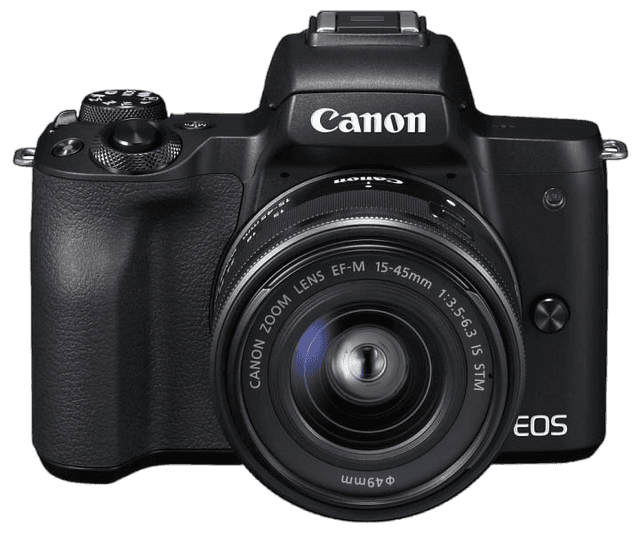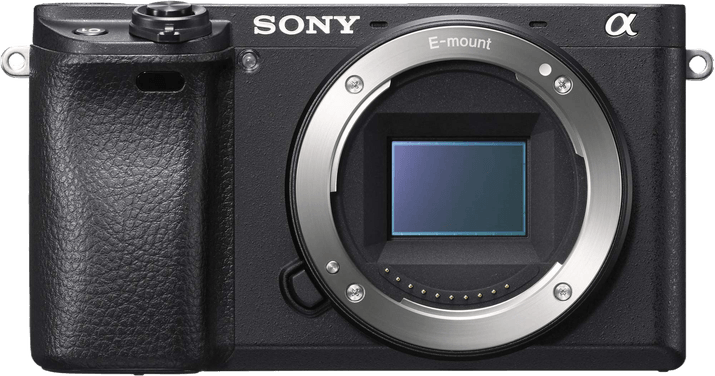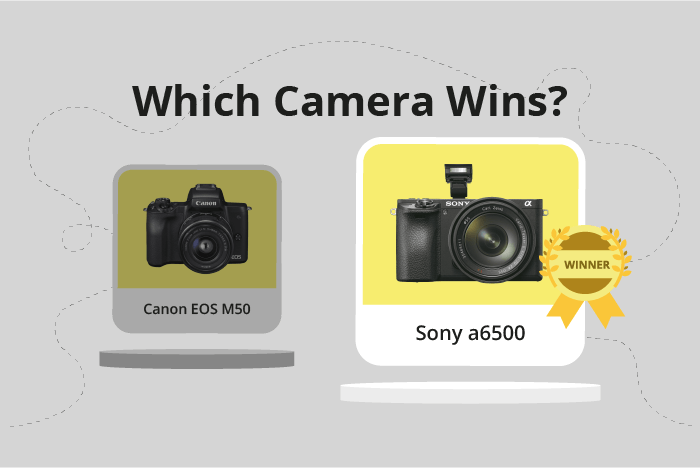Canon EOS M50 vs Sony a6500 Comparison
Canon EOS M50

Sony a6500

The Sony a6500 outshines the Canon EOS M50 with a score of 72/100, a 13-point lead over the M50’s 59/100. Both cameras are mirrorless and were released in 2016 and 2018, respectively. The a6500 is slightly larger at 120 x 67 x 53mm and heavier at 453g, compared to the M50’s 116 x 88 x 59mm and 390g. The launch price of the a6500 was $1400, while the M50 debuted at $779.
The a6500’s higher score reflects its superior performance and features. Despite being an older model, it offers better image quality and more advanced settings for professional photographers. However, the M50 does have some advantages, such as its lighter weight and lower price, making it an attractive option for beginners or those on a budget.
Considering their strengths and weaknesses, the Sony a6500 is the better choice for experienced photographers, while the Canon EOS M50 is suitable for newcomers or those looking for a more affordable option.
Canon EOS M50 vs Sony a6500 Overview and Optics
The Sony a6500 triumphs over the Canon EOS M50 in optics, scoring 74 out of 100, while the Canon EOS M50 scores 59. Both cameras share certain specifications, such as 24-megapixel resolution, CMOS sensor type, and APS-C sensor size. However, the Sony a6500 outperforms the Canon EOS M50 in several aspects.
The Sony a6500 has a slightly higher shooting speed at 11 frames per second, compared to the Canon EOS M50’s 10 frames per second. The a6500 also has a superior DXOMARK sensor score of 85, while the EOS M50 scores 58. Furthermore, the Sony a6500 features image stabilization, which the Canon EOS M50 lacks. These factors contribute to the a6500’s better performance in optics.
On the other hand, the Canon EOS M50 has the advantage of the Digic 8 processor, which is newer than the Sony a6500’s Bionz X processor. This may result in improved processing capabilities for the EOS M50. However, this advantage does not outweigh the benefits offered by the Sony a6500 in terms of optics.
Both cameras have their respective lens mounts – the Canon EOS M50 uses the Canon EF-M mount, while the Sony a6500 uses the Sony E mount. This means that users can choose lenses compatible with their preferred camera brand.
The Sony a6500 emerges as the clear winner in optics due to its higher score, faster shooting speed, better sensor score, and the presence of image stabilization. Although the Canon EOS M50 has a newer processor, it falls short in comparison to the a6500’s superior optical capabilities.
Canon EOS M50 vs Sony a6500 Video Performance
The Canon EOS M50 outperforms the Sony a6500 in terms of video capabilities, with a video score of 91/100 compared to the Sony a6500’s 77/100. Both cameras share common specifications, such as a maximum video resolution of 4K and maximum video dimensions of 3840 x 2160. Additionally, both cameras can reach a maximum video frame rate of 120fps.
The Canon EOS M50 excels in its video capabilities due to its built-in time-lapse functionality. This feature allows users to create stunning time-lapse videos without the need for additional equipment or software. This advantage sets the Canon EOS M50 apart from the Sony a6500, which does not have built-in time-lapse functionality.
On the other hand, the Sony a6500 does not have any specific advantages over the Canon EOS M50 in terms of video capabilities, as both cameras share the same maximum video resolution, dimensions, and frame rate. The lower video score of the Sony a6500 is due to its lack of built-in time-lapse functionality, which the Canon EOS M50 possesses.
Taking these factors into account, the Canon EOS M50 proves to be a superior choice for video capabilities compared to the Sony a6500. The built-in time-lapse functionality significantly contributes to the Canon EOS M50’s higher video score, making it a better camera for those interested in creating time-lapse videos. The Sony a6500, while still a quality camera, does not offer any additional advantages in video capabilities and falls short in comparison to the Canon EOS M50.
Canon EOS M50 vs Sony a6500 Features and Benefits
The Sony a6500 outperforms the Canon EOS M50 in features with a score of 81/100 compared to the M50’s 70/100. Both cameras share several specifications, such as a 3-inch screen size, touchscreen capabilities, flip screens, and the absence of GPS. They also both offer WIFI and Bluetooth connectivity.
The Sony a6500 has a better feature score primarily due to its screen resolution of 921,600 dots, which is higher than the Canon EOS M50’s 1,040,000 dots. This higher resolution provides a clearer and more detailed image preview and playback experience for the user. Additionally, the Sony a6500 offers more advanced autofocus features, which enable faster and more accurate subject tracking in various shooting scenarios.
On the other hand, the Canon EOS M50 does have some advantages despite its lower feature score. The M50’s user interface is more intuitive and user-friendly, making it an ideal choice for beginners or those who prefer a simpler camera operation. Furthermore, the M50’s color reproduction is known to be more accurate and pleasing to the eye, which can be a significant factor for photographers who prioritize color accuracy in their images.
Taking these factors into consideration, the Sony a6500 is the better camera for those who value a higher screen resolution and advanced autofocus capabilities. In contrast, the Canon EOS M50 is a suitable choice for photographers who prefer a more user-friendly interface and accurate color reproduction. Each camera has its strengths, and the ideal choice ultimately depends on the individual’s preferences and priorities.
Canon EOS M50 vs Sony a6500 Storage and Battery
The Sony a6500 outperforms the Canon EOS M50 in storage and battery, scoring 21 points compared to the M50’s 13 points. Both cameras have one memory card slot and are compatible with SD, SDHC, and SDXC cards. However, the a6500 also accepts Memory Stick Pro Duo cards, providing more storage options.
The Sony a6500 offers a longer battery life of 350 shots, compared to the Canon EOS M50’s 235 shots. Both cameras use different battery types: the a6500 uses the NP-FW50, while the M50 uses the LP-E12. Neither camera supports USB charging.
While the Canon EOS M50 has a lower score in storage and battery, it is still a reliable option for photographers who do not require extended battery life or additional memory card compatibility. The Sony a6500, on the other hand, is the better choice for those needing longer battery life and more storage options.
Canon EOS M50 vs Sony a6500 – Our Verdict
Are you still undecided about which camera is right for you? Have a look at these popular comparisons that feature the Canon EOS M50 or the Sony a6500:

